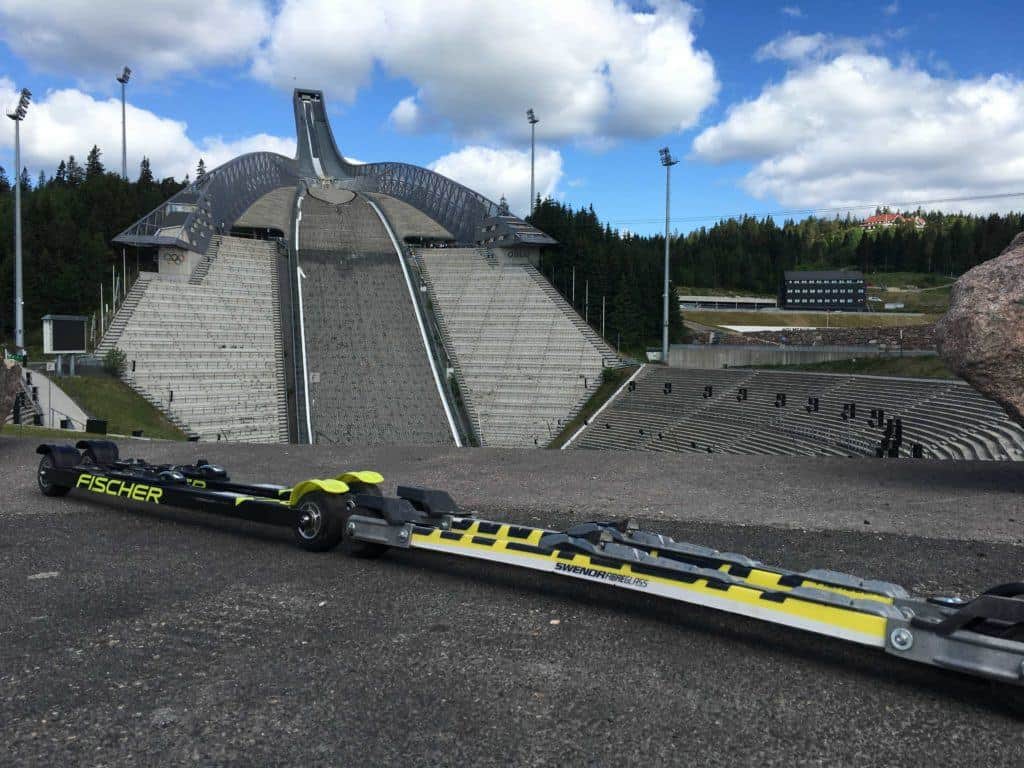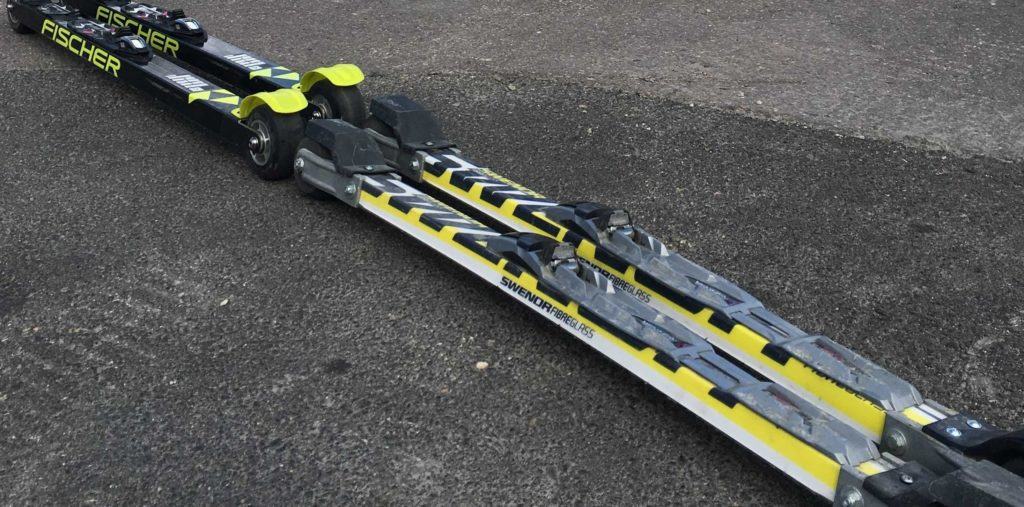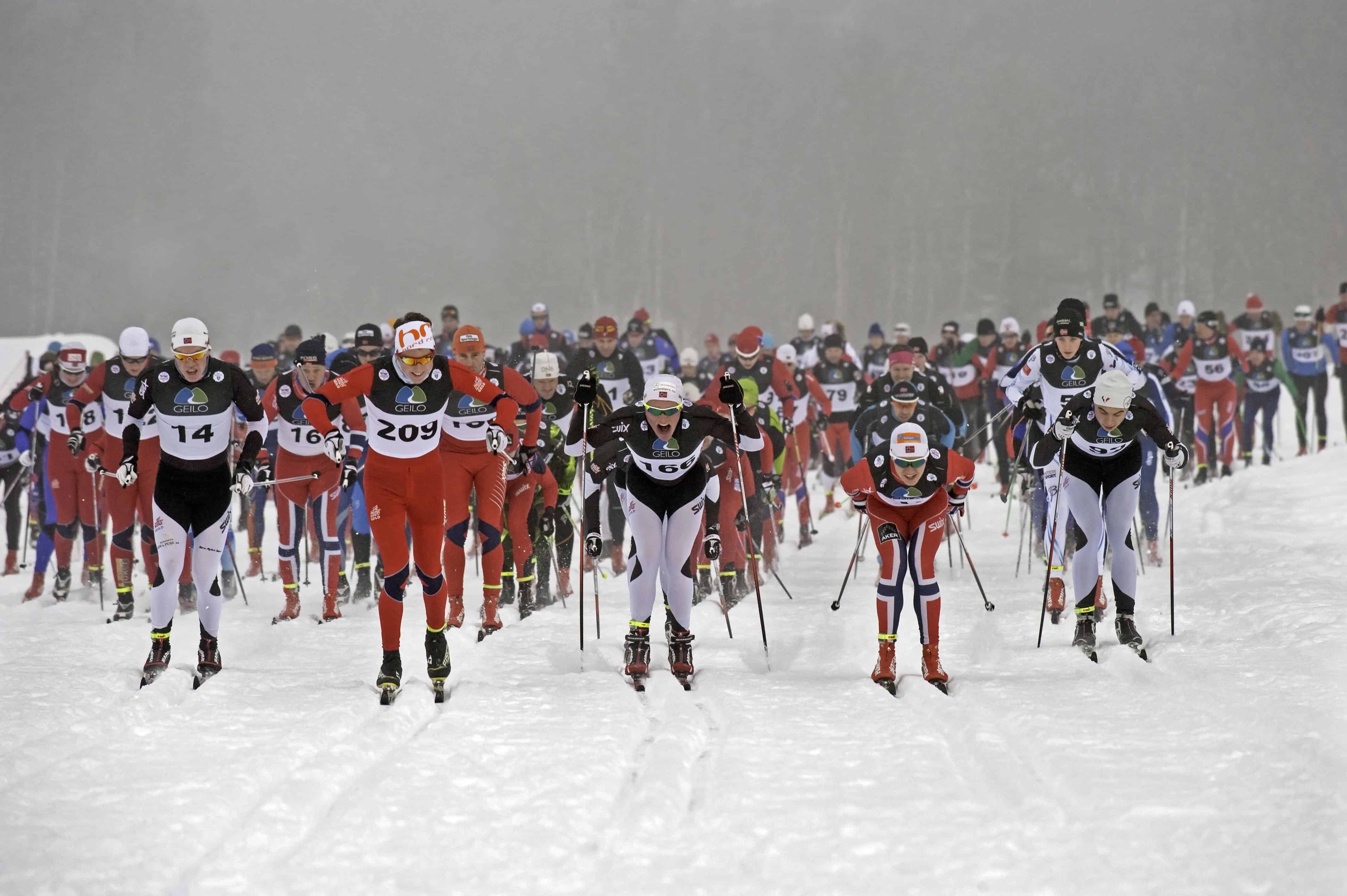The roller skiing season is well underway (at least on the northern hemisphere!) Roads and pavements are cleaned and swept from parks and country roads (hopefully). It is time to relocate the roller skis from the booth or head to the store and get a couple of brand new. Fischer and Swenor are among the largest brands for roller skis, and XC-marathon.com (Turrenn.net) have tested two of their models «head-to -head» .
First, what do the producers have to say about their own skis:
The descriptions are given from the importers of the brands in Norway.
Fischer Carbonlite Classic is described as follows: «New AirCore Carbon trunk ensures excellent absorption/diminishing of vibration and low weight. A little longer trunk increases stability and provides a more similar to cross country ski feeling. Low profile wheels makes the skis maneuverable and precise. Roller skis are directionally stability due to narrower wheels with rims. Skis works very good at breaking/plowing because of narrow wheels , «bigger» rims and 2ply wheels ( 2ply = two layers of rubber, a softer layer in the core and a harder layer at the exterior). This provides a better grip and a longer durability while the wheels absorb ground better than one layer hard rubber. This makes the wheels more comfortable and ensures longer life. (Alf Roger Holme, Finor AS (importer to Norway).
Swenor is described as follows : «It is not only the wooden trunk, but also wheels that make this ski unique. The combination of the wooden trunk, as well as wheels with good vibration absorption, gives the skier a very comfortable roller skiing ride. New shape of the wheels makes Fibreglass more steady, and these have been praised almost into the clouds 😉» (Jon Pedersen, Sport Import AS).
What do exercisers use roller skis for, and what should be important expectations?
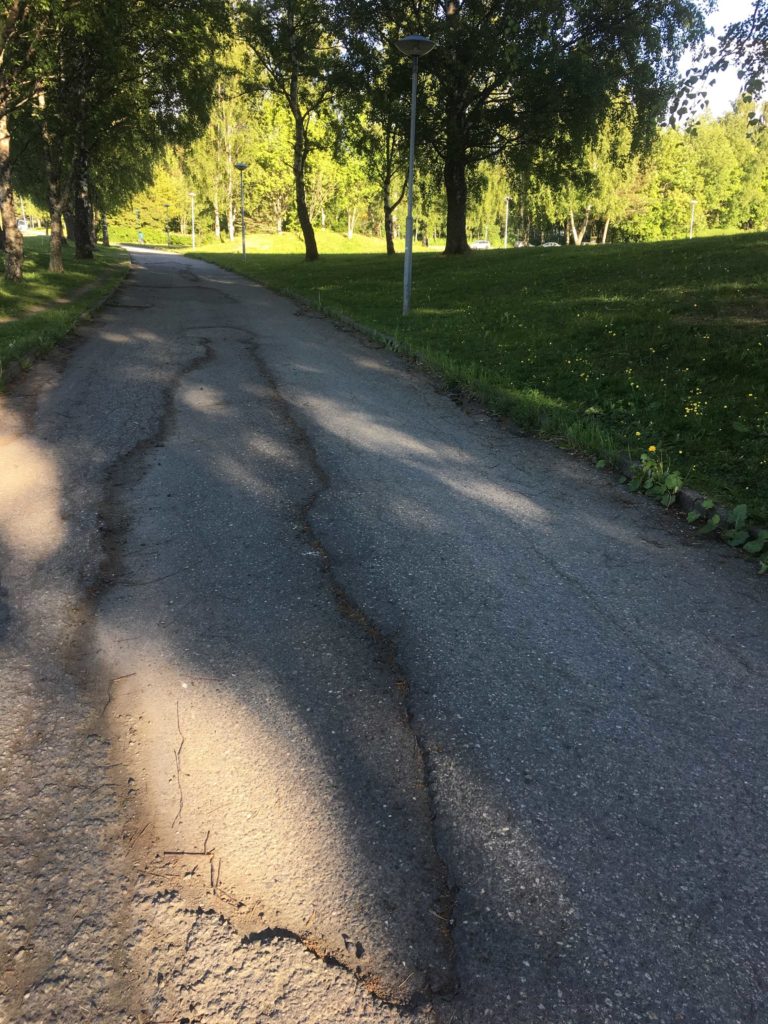
Roller skis vary greatly when it comes to features and quality. Although they may not be characterized by high-tech innovations and new improvements every year, roller skis have different characteristics which vary in importance, depending on what type of user you are. The best – the pros – are often happily double poling mile after mile without a single or few strides, and generally uses roller skis much more than most amateurs. They also use them for specific training in the summer that might as well be done by winter skiing, such as sprint and technique. This requires comfort (vibration absorption), steadiness, response (for sprinting training) and of course how much the roller skis can give the same experience or feeling as real skis on real snow.
To a hobby exerciser response and durability does not have to be just as important. The distance and wear-out effect will for most people be significantly lower than for top / active skiers. Comfort means much more, but probably the most important feature is ( directional ) stability and how much it acts like a normal ski; and thus the degree of stability and safety it provides both on roller tracks and around the country / by road. The most frequent ( and justified ) concern is : -can I control / brake now ?
The number of the beast
Fisher Carbolite classic vs Swenor Fibreglass
Carbonlite:
Weight (per ski, with binding): 1277 grams.
Measures (milimeters): Lenght; 75,9 (suspension to suspension) – Width: 4,6 – Height (ground to bottom of trunk): 2,9
Fibreglass:
Weight (per ski, w/binding): 1244 g.
Measures (mm); L: 73,5 (susp.-to-susp.) – W: 4,5 – H: 2,3
The wheels on the Fischer skis are reported from the importer to be the same hardness as the wheels of the Swenor skis (2).
Tested in the national skiing championship site and on traditional roads and sidewalks.
The roller skis were first tested in the national roller skiing championship site in Holmenkollen in Oslo. The track is characterized by great hight differences, steep tracks, and sharp and «blind» turns. They were thereafter tested on ordinary roads / pavements in Trondheim, Norway. The links to the routes can be found at the bottom of the article.
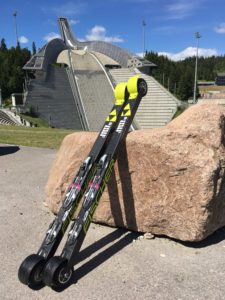
Fischer Carbonlite had the honor of going first. The initial feeling was that the skis were quite heavy and a bit difficult to deal with. They did not feel like they willingly responded to my leg´s movement, as a pair of skis would. The entire construction, from wheels to trunk and bearings however, felt very solid and «tight «. So solid that the little suspending reaction that can be recognized from conventional skis when kicking down ( from the waxing area) was not quite noticeable on these roller skis. Maybe it has something to do with a lack of power in the kick compared with the proffesionals at this test skier..? The comfort (in the sense of vibration absorption and steadiness) was very good. In summary, the impression from the first few hundred meters was perhaps a bit like a new and steady passenger train. Comfortable and high quality, but not happily allowing you to steer off the preset tracks.
After a while, though, you get used to the feeling to a great extent. But not completely. And this rigidity probably has to do with the lenght of the skis. And «after a while», it should be noted, means uphill and on flat ground.
Because it is when the relatively steep downhill slopes and hairpin bends start that these roller skis´ big advantage reveal itself. Fischer themselves emphasizes (see further up ) that the wheel´s low and narrow profile provides greater directional stability and therefore greater control than otherwise. The length probably play a role too. Because the skis feel very, very stable and safe to stand on, and maneuvre, at high speeds. The wheels´ «angular» profile (like F1 tires) makes it a good idea to practice a little on plowing (or breaking/slowing down) the skis, but the feeling during the test was that it would be quite easy to manage. Very good vibration absorption also contributes to the end result; that these roller skis is perceived as both very safe and comfortable in those situations most amateur exercisers perhaps have the greatest demands / expectations to; at high speed and when maneuvering without full control over conflicting traffic ( cyclists , dogs, etc.).
On traditional roads or bike / walkway or parks the same conclusion is relevant. In this test, a few days later, as one would expect the stiffness and » independence » (in a negative sense) is not so present. It seems that it to a great extent in reality is more of a short adjustment period. Themroe I get used to it, these properties rather make them feel more like real skis; as a pair of skis in the tracks (or the train on the tracks); steady going forward where they´re supposed to. Like mentioned before, it´s probably got to do with the lenght. This also makes the plowing (breaking / slowing down) a little harder in the beginning. The longer the ski, the harder it is to create the right angle, pressure and movement for the skis to slow down. The Carbonlite skis are also – unlike the Swenor skis- completely flat (no curving) on the down side. By (somewhat inaccurate) measurement the Fischer skis have slightly less ground clearance underneath. This makes it a little easier to bump into the asphalt on uneven ground ( holes, speed bumps , etc.). Vibration absorption on normal roads is by the way very good . I think it is completely at the level of the King of vibration absorption; Swenor roller skis.
The Fischer Carbonlite also handles rough edges and small holes on the pavement very good.
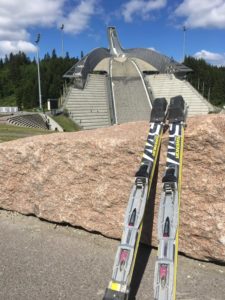
Swenor Fibreglass were then strapped on to my legs. Whereas Fischers Carbonlite roller skis are designed primarily with carbon laminates and air core, the Swenor skis are built with fiberglass and wood laminates in the core. The difference is recognized immediately. Both are steady and stable, and the vibration absorption is something better and the afore mentioned response when kicking the ski (as in conventional skiing) is definitively noticeable better with Swenor Fibreglass. The Swenor skis are some centimeters shorter and perhaps it is also the length that helps skis feels easier to handle the first calm rolling meters? Weight difference is minimal, but still Swenor skis feel easier to deal with. The rhythm is also a little easier to get into because you easily recognize the response like from conventional skis. With the wood core in the Swenor skis the comfort (vibration absorption) is very good. Swenor roller skis feels more like an agile racer bike, although the comparison between a train (Fischer) and a bike of course can make differences seem much larger than they really are.
Using Swenor Fibreglass can quickly make you a little blissful. They vibrate as mentioned very little and the skis «listen carefully» to your leg´s movements.
Just as with Fishers Carbonlite, however, the essential features of the skis appears when the Fibreglasses speeds up in the downhills. The skis are slightly shorter and wheels have very different structure. They are not as angular (as F1 wheel; more an indication to the V-shape where the wheel is «highest» at the center), they are wider and thicker not least, from the rim and out. Probably one can also say that the glass fiber and wood core in the Swenor skis, along with wheel shape means that they are much wilder and more unruly in high speeds. With the Swenor Fibreglass skis it is necessary to frequently adjust the direction of the skis. A little too ofte one gets the feeling that they push in under you and against the other ski more than just going straight forward (on the train tracks). Perhaps it could be due to my somewhat tense position atop the skis, but the experience is nonetheless there. On the other hand, compared to Fishers Carbonlite with flatter wheels the Swenor skis is still surely easier to get an immediate and safe breaking / plowing feeling with.
In traditional road- and park- bike- / walkway environment you get a little less back for the real ski feeling that Swenor provides for closed roller ski tracks. The ski is, because of the kicking response, somewhat more unpredictable – which is often problematic if you do not have 100’s of miles of experience in your feet and have learned all the tips and tricks on roller skis in traffic. As mentioned in the above paragraph, the skis can move a little under your body and make you feel a little less stable during the workout. The Swenor skis has, in contrast to Fischer, a curved trunk (looking from the side). It creates greater ground clearance at the center and is slightly higher than Fischer skis, resulting in slightly less danger of touching ground. The Swenor Fibreglasses are easier to break powerfully with, but rolls a little faster. That means you need to plow more often with the Swenors, but also get more effect out of breaking.
Skien is doing just fine on bumpy, uneven ground.
Conclusion: Both products are very good roller skis, where the similarity is absorption of vibration in both types. If you would insist (something that Turrenn.net will strongly discourage), you can find cheaper roller skis in the shop that gives you a lot more uncomfortable journey and a real fear of trips to the dentist to adjust back scrawny teeth afterwards. In other words, comfort very good in both models, while both may get a little minus due to too much stability on Fishers part and too little stability on Swenors part.
The real ski feeling is somewhat better with Swenor than with Fischer, depending on the kind of feeling you want (response vs track feeling). The response is much more recognizable with the Swenor skis and they «listen» better to you. If you would emphasize the real ski feeling you should choose Swenor.
When it comes to descents, turns and speed, the choice is equally clear – and vice versa. The feeling of stability, security and safe maneuverability is clearly best with the Fischer skis. If the most important thing for you is a good and safe feeling in scary situations, select Fischer.
Happy choice – and happy training!
The routes/tracks the skis were tested on can be seen here:
Steffen R. L./
XC-Touring.com/XC-marathon.com/Turrenn.net

